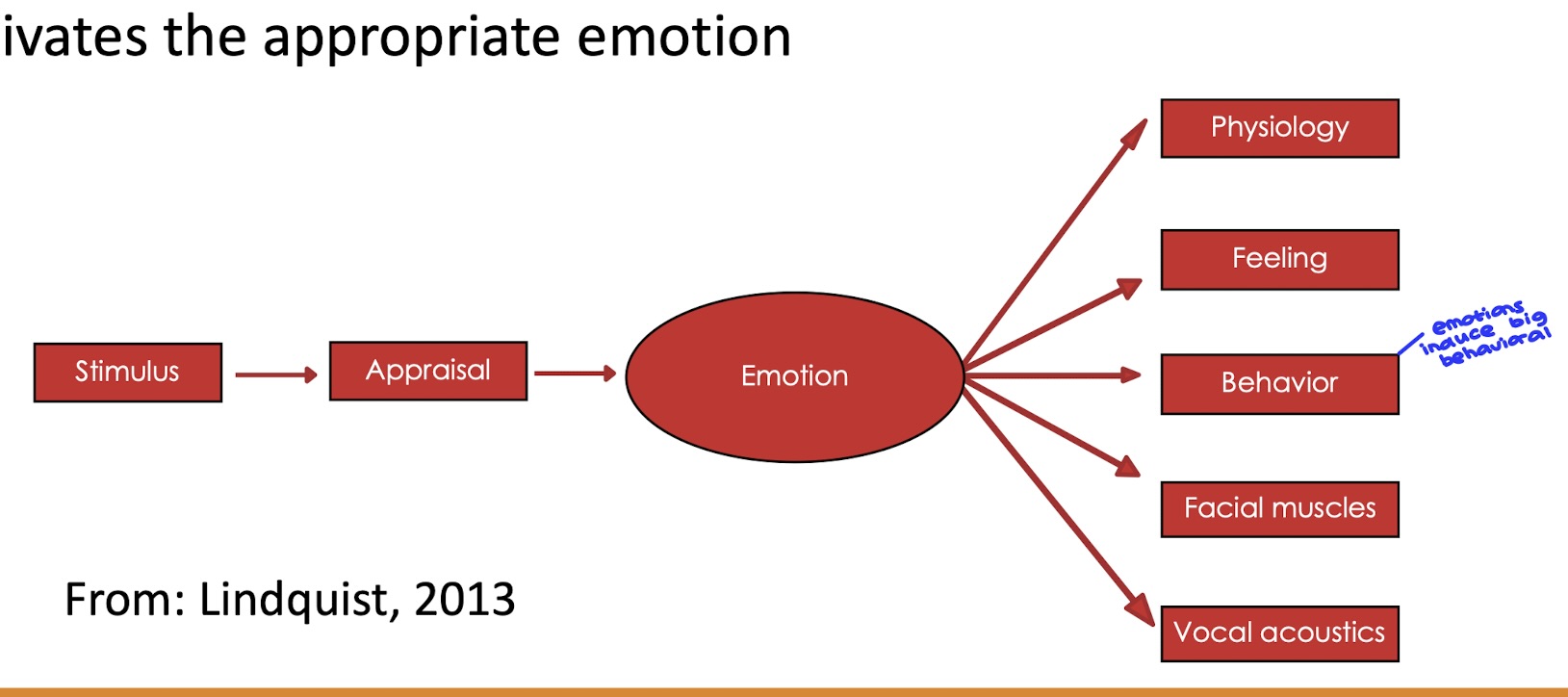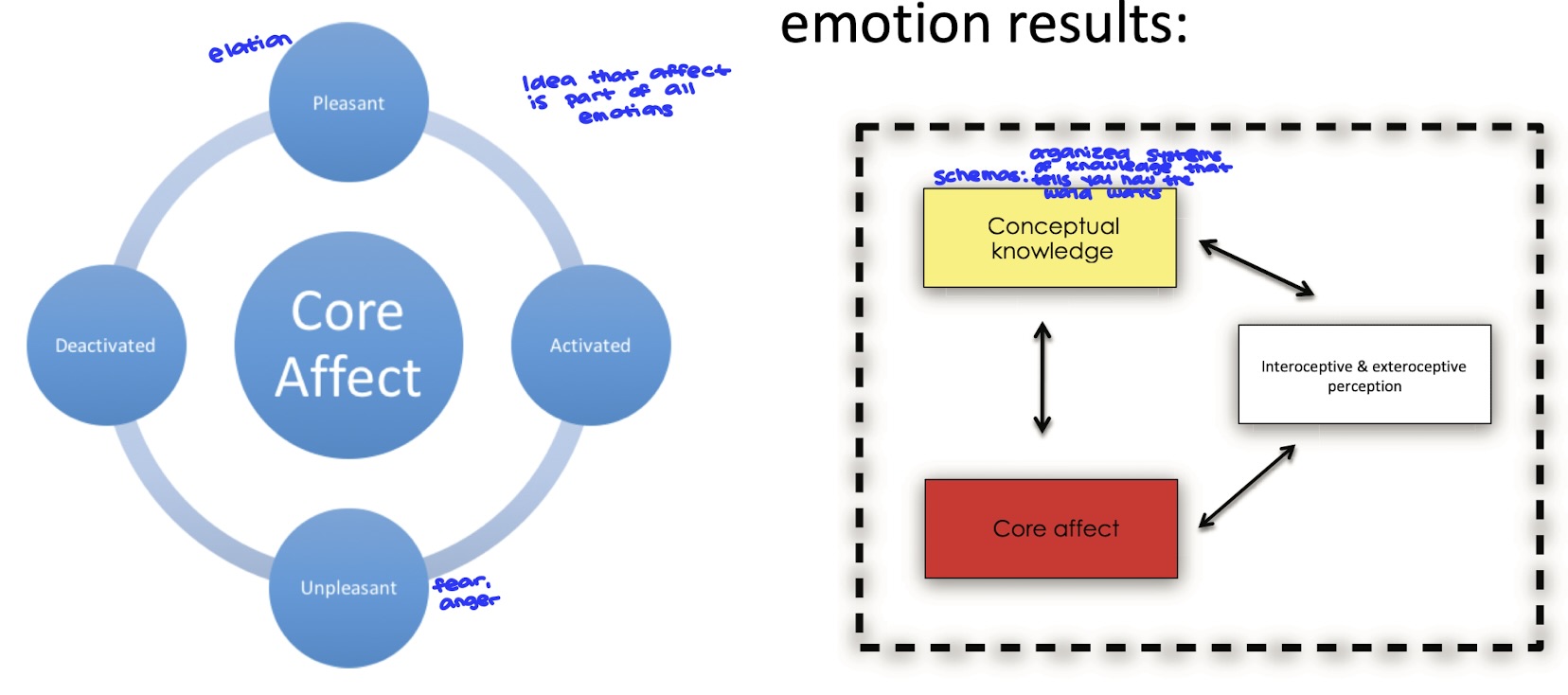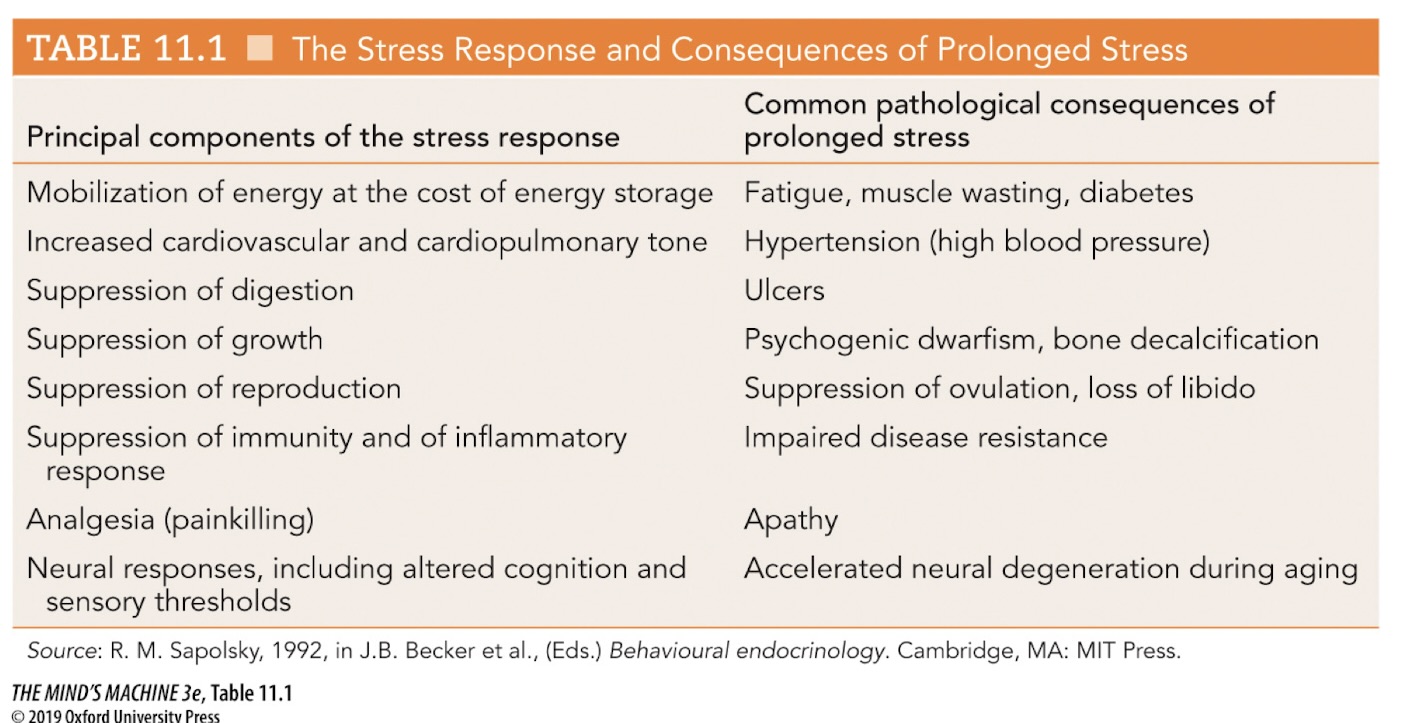Emotions & Stress
1/16
Earn XP
Description and Tags
Locationist vs Constructionist Perspectives, Facial Expressions, Stress
Name | Mastery | Learn | Test | Matching | Spaced |
|---|
No study sessions yet.
17 Terms

Locationist Definition of Emotion
-Emotions are ‘natural kinds,’ meaning it should be possible to generate a list of emotions that all neurotypical humans share
-A distinct psychological state, triggered by an external stimulus or situation, that rapidly organizes and implements a complex, coordinated response to that stimulus or situation
-This involves a fast (often unconscious) evaluation of the circumstances, in which your brain takes into account relevant variables and activates the appropriate emotion
-Once triggered, emotions organize a coordinated response at multiple levels:
Emotions From the Locationist Perspective
-Emotions are solutions to persistent problems faced by organisms in their environments, and thus promote survival. Each is a discrete, irreducible state supported by specific sites in the brain.Activating those brain sites causes the emotion to occur.
For example:
-Fear triggered by a truly threatening situation can promote avoidance or defense and thus increase survival
-Disgust triggered by rotting food can reduce contact with potential pathogens and thus increase survival
-Love triggered by offspring can increase parental investment and thus promote your offspring’s survival
Core Emotions
-Many researchers believe that there are a set of core emotions that all humans share. However, there is relatively little agreement about what these are
-Plutchik suggests there are 8 (see right) – four pair of opposites that
produce different variations on the same emotion depending on intensity
-So, for instance, rage is a high intensity version of annoyance and happiness is the opposite of sadness
-Other researchers suggest that some of these are really the same emotion at heart, and argued for a shorter list (some do not think of surprise as a distinct emotion, for example)
The Amygdala
-A limbic structure in the temporal lobe that plays a key role in emotional processing
-Highly similar between humans and other mammals
-Stimulation of the human amygdala during brain surgery
produces intense feelings of fear
-Klüver-Bucy Syndrome: removal of the monkey amygdala causes a series of bizarre emotional and motivational responses
• Reduced fear and aggression – monkeys became strangely docile
• Strange food consumption behavior – non-food items consumed
The Amygdala pt.2
-Patient SM has a rare disease that destroyed her amygdala
-She has limited fear of spiders or scary scenes in movies (graph on the right compares her reactions to individuals with intact amygdalas)
-Her startle response is extremely limited
-She is also overly trusting – will not show suspicion or negative affect in response to shady or obviously dangerous individuals
The Amygdala pt.3
-Information about threatening stimuli can reach the amygdala directly from sensory regions of the thalamus (‘low road’) and cortex (‘high road’)
-Evidence from studies of fear conditioning demonstrates that a rat with lesions of the auditory cortex can still show fear in response to a tone that predicts a mild electrical shock
-The emotional significance of simple stimuli (such as a tone paired with shock) can be processed without the cortex (‘low road’ from thalamus), but the emotional significance of complex stimuli (ie a scary scene in a movie) require cortical processing (‘high road’)

Constructionist Definition of Emotion
-Emotions are NOT elemental psychological states, but instead a mix of other, more fundamental psychological components
-These include core affect:
-Core affect combines with other psychological processes and
emotion results: (no list of feelings, all continuous)
The emotion is essentially a value that your brain assigns to help you understand your reaction to a situation
Emotions are not discrete, and do not live in specific parts of the brain tasked with creating them
Function of Emotions (regardless of the model you favor)
-Damage to the anterior cingulate cortex (ACC, yellow area of
diagram) can produce a disorder called abulia – a powerful kind
of apathy that leaves the individual incapable of basic decisions
-Individuals with abulia show diminished emotional reactions, reporting less intense feelings and often showing reduced physiological responses to emotional stimuli
-Though we typically think of emotion as something that clouds good judgement, abulia demonstrates that without them our ability to make basic choices is lost
Facial Expressions
-One of the basic behavioral outputs of human emotion, facial expressions allow you to quickly communicate what you’re feeling
-Darwin argued that all humans (and even other primates) will produce the same or similar facial expressions in response to a core group of emotions (locationalist)
-There is good cross-cultural agreement among people from industrialized societies around the world about the meaning of many facial expressions
-However, there is less agreement from members of isolated, relatively small-scale societies (happiness is the interesting exception – the meaning of a smile may be universal)
Facial Expressions pt.2
-While specific expressions may differ somewhat between cultures, all humans have the necessary motor control and all neurologically typical human beings express emotions this way to one degree or another
-Expressions are controlled by two categories of facial muscle:
-Superficial facial muscles create subtle movements in the skin of the face (such as wrinkling your nose)
-Deep facial muscles create larger movements (such as opening your mouth, dropping jaw
-Facial muscles are controlled by two cranial nerves: the facial nerve and the trigeminal nerve
Facial Expressions pt.3
-Expressions can be broken down into distinct action units that
result from the contraction of a specific pattern of facial muscles. Each discernable expression is a combination of these action units
-For example, the zygomatic major pulls the corner of the lips outward when you smile (action unit 12)
-Interestingly, if this occurs in the absence action unit 6 (when the orbicularis oculli muscle raises the top of the cheek and crinkles the skin around the eye), the smile is generally considered insincere (camera smile => conscious vs genuine happiness smile)
Stress
-Stress is the physiological response to aversive or threatening stimuli
-Stress has a strong hormonal component that is regulated by the
hypothalamus-pituitary-adrenal axis (HPA)
-The HPA controls release of cortisol, so-called stress hormone, from the
adrenal gland (which sits on top of the kidneys)
-Cortisol is in part a metabolic hormone that will increase glucose levels in the blood by facilitating the process by which it is converted from stored to usable forms (see homeostasis lecture). Stress activates this hormone because we need energy to be available in emergencies
HPA axis
-Regions of the brain that detect environmental threats, such as the
amygdala, send this information to the hypothalamus
-This causes hypothalamic neurosectretory cells to release
corticotropin-releasing factor (CRF) into the portal vein
-CRF travels a short distance to the pituitary gland, where it causes the
release of adrenocorticotropic hormone (ACTH) into the blood stream
-ACTH travels to the adrenal gland and stimulates cortisol release
-The system is a negative feedback loop – increasing cortisol
decreases CRF and ACTH release
Sympathetic Nervous System
-Stress also activates the sympathetic nervous system. This
increases the availability of metabolic energy (glucose) while
also increasing the utilization of that energy by muscles, etc
-Activation of the sympathetic nervous system inhibits the
parasympathetic nervous system, which plays a ‘rest and
digest’ role
-The sympathetic nervous system causes the release of
epinephrine (aka adrenaline) from the adrenal gland, which
facilitates energy mobilization and use
Acute vs Chronic Stress
-The body is very effective at getting energy to where it needs to go in response to acute stress (an emergency)
-For example, if you are in real danger, fighting infection is a secondary concern, so ACTH suppresses the immune system, which requires a lot of energy
-Persistent activation of the HPA axis, however, can have harmful effects. Essentially, the system provides short-term solutions and may not be designed for persistent activation – hence the negative health effects of chronic stress

Effects of Control on Stress
-Control over stressors plays a key role in future responses to stress
-Yoked control design: Subjects (such as rats) are paired so that one, the master, controls what happens to both itself and its partner, the yoke. In a common variation of this, the master turns a wheel to determine the duration of shock for itself and its yoked partner
-Master and yokes get the same stressor (shock), but masters are in control
-Yokes show the effects of chronic stress (weight loss, ulcers), and show learned helplessness (they will not take control even when the opportunity to do so is made available)
Resilience
-Stress has a very different effect on the masters. Not only does
control reduce the stress response, it can inoculate the master
against future stressors
-For instance, masters show less behavioral and physiological
evidence of fear to a tone that has been paired with an electrical
shock, relative to yokes and to unstressed subjects. Thus, the ability
to control a stressor may make you resilient to future stressors
-Control over stressors activates the medial prefrontal cortex (mPFC),
which can inhibit activity in regions like the amygdala and thus dial
down the stress response